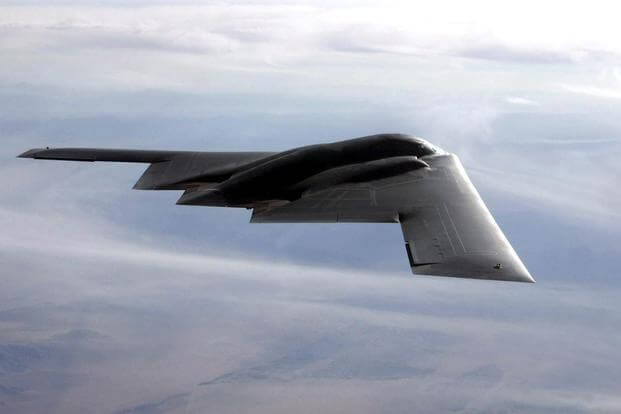The largest non-nuclear weapon in the Air Force's arsenal recently got an upgrade from Boeing Co., Air Force officials told Military.com.
While they couldn't comment on how many GBU-57 weapons received the upgrade for operational security reasons, "the Enhanced Threat Response IV modification improved the weapon's performance against hard and deeply buried targets," Air Force spokeswoman Ann Stefanek said last week. The announcement was first reported last week by Bloomberg News.
Known as a the Massive Ordnance Penetrator, or MOP, the bomb is a bunker buster meant to take out hard, deeper-rooted areas such as underground lairs. While the MOP weighs in at 33,000 pounds, its warhead is only roughly 5,300 pounds.
The MOP is a GPS-guided munition designed for bombers like the B-2 Spirit and, thus far, has never been used in combat.
Whether or not the MOP is currently deployed was not disclosed.
In October The Aviationist website posted an account of Northrop Grumman-made B-2s simulating airtrikes across various targets in Missouri. According to the witness, the strikes, simulated in the Ozarks, resembled a practice run in a mountainous terrain such as Afghanistan or North Korea.
Related content:
- After US Drops 'Frankenbomb' on Afghanistan, Questions Linger
- US Drops Most Powerful Non-Nuclear Bomb in Afghanistan
- Watch the Air Force Test the 'Mother of All Bombs'
Meanwhile, citing a test and evaluations report, Aviation Week recently reported that three B-2s, each armed with a GBU-57, struck at targets at the Army's White Sands Missile Range in New Mexico in May, 2017.
The MOP outweighs the Air Force's Massive Ordnance Air Blast, or MOAB, bomb. However, the air-burst MOAB -- first deployed in combat last year -- is the most powerful conventional bomb with 18,000 pounds of explosives, equivalent to about 11 tons of TNT.
The 21,600-pound GBU-43 -- nicknamed "mother of all bombs" -- dropped from a MC-130 special operations cargo plane onto a specific location in Nangarhar province in eastern Afghanistan in April. The intention was to take out militants affiliated with the Islamic State of Iraq and Syria's branch Khorasan, or ISIS-K, amassed in a tunnel complex.
That strike killed at least 94 militants, a U.S. military official said at the time.
-- Oriana Pawlyk can be reached at oriana.pawlyk@military.com. Follow her on Twitter at @Oriana0214.










